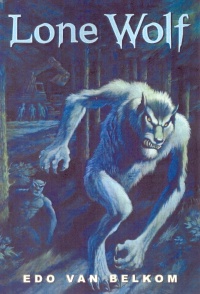| ________________
CM . . .
. Volume XII Number 7 . . . .November 25, 2005
excerpt:
It is unusual for a sequel to be even as good as an original novel, and it’s even rarer for it to be better, but that’s the situation with Lone Wolf, the sequel to Wolf Pack. In Wolf Pack, Van Belkom initially needed to persuade readers to suspend disbelief regarding the existence of lycanthropes, creatures able to change their appearance from human to wolf. Consequently, before he could get into the book’s principal plotline, he had to create a believable situation that brought four wolf cubs into a human home and then saw them transformed into human infants who were raised by a human couple. In Lone Wolf, Van Belkom clearly assumes that readers have already encountered the contents of Wolf Pack because he omits the traditional “catch-up” section found in most sequels. While Lone Wolf makes a number of passing references to aspects of Wolf Pack, especially the major plot element of Doctor Monk’s having captured Tora in lupine form, readers unfamiliar with the opening book will not be seriously disadvantaged. By Van Belkom’s not recapitulating the pack’s story to this point and by assuming that readers already know something about the characters and their relationships, he can jump directly into the plot. The major story involves an attempt by Conservco Resources, a greedy lumber company represented by its on-site supervisor, Tyler Allen Ceballo, to clear-cut the old growth forests adjacent the BC community of Redstone. The save-the-forests side is led by an elderly local artist, Donna Hughson, who recruits the artistic community across Canada to rally to the environmental cause. Obviously, the four youths who travel through the forest in lupine form have a personal interest in seeing that the lands remain unlogged, and so Noble, the foursome’s leader, recruits a local native actor, Willie Greene, who assumes the role of Manchoka, the shaman for the people of the forests. Willie, as Manchoka, warns the loggers, “...if you clear-cut this land, the spirits will be angry and bad things will happen to the white man.” At night, Noble and his siblings, in either their wolf or werewolf forms, carry out benign acts of vandalism and emotional harassment which ensure that the words of Willie, aka Manchoka, have real substance. What separates Lone Wolf from Wolf Pack is that three of the adolescent characters, now almost 16, also have their own stories to tell. Harlan, described as “the runt of the litter,” is constantly being bullied at school by Jake MacKinnon, a 200 hundred pounder who is trying to goad Harlan into a fight, something Harlan must publicly avoid because the emotions roused by fighting could cause him to spontaneously transform into a werewolf. One of Jake’s taunts is calling Harlan “Dogface” as, unlike his three siblings who “had all been blessed with attractive human faces, Harlan’s face had retained many of his wolfen features....” Ultimately, Noble cleverly comes up with a setting wherein the fight between Jake and Harlan can occur while still preserving Harlan’s shape shifting secret. As the quartet is nearing the end of high school, they each begin to wonder about their futures. Argus, the largest and strongest member of the pack, is not doing well in school, and he tells Noble that he’s thinking of leaving them and living in the forest, an idea which gathers greater force when, during one of his forest runs, he encounters Phelan, another werewolf and someone who knew the foursome’s parents. However, when Argus does decide to become a lone wolf and make the forest his permanent home, Phelan convinces him that he cannot do so as he and his siblings have already spent too much time in the world of humans. Phelan says, “...you and your pack can help us preserve our way of life and grow strong again...by living among humans and working to safeguard our kind from within their world.” While Tora’s long-term aspirations include being a stage actress, her immediate goal is to win the lead role in one of the plays being performed at the school’s drama night. Her main competition is Maria Abruzzo whose father’s trucking company has just decided to sponsor the drama festival, an action which Maria believes will guarantee her the role. When Tora wins the coveted role, rival Maria says, “And I’ve always felt there was something weird about you and your brothers, and I mean really weird....I didn’t care all that much before, but now I’m going to find out what it is.” Possibly, Maria’s threat, which comes in the book’s closing pages, hints at one of the plot elements in a future instalment involving the four lycanthropes. Highly Recommended. Dave Jenkinson teaches courses in children’s and YA literature in the Faculty of Education, the University of Manitoba.
To comment
on this title or this review, send mail to cm@umanitoba.ca.
Copyright © the Manitoba Library Association. Reproduction for personal
use is permitted only if this copyright notice is maintained. Any
other reproduction is prohibited without permission.
NEXT REVIEW |
TABLE OF CONTENTS FOR THIS ISSUE
- November 25, 2005.
AUTHORS |
TITLES |
MEDIA REVIEWS |
PROFILES |
BACK ISSUES |
SEARCH |
CMARCHIVE |
HOME |
